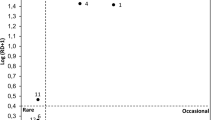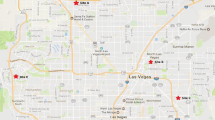Abstract
Airborne viable and total fungal spores were sampled inside and outside 80 houses in the Latrobe Valley, Victoria, Australia as part of a larger indoor environmental study. Each residence was visited six times over a period of 1 year for sample collection, and fungal spore samples were collected from at least three indoor sites and from an outdoor site. Viable spores were sampled using an Andersen sampler, while total spores were assessed using a Burkard spore trap. Identification of fungal colonies to genera level was performed in two seasons; winter and late spring. The most common fungal genera/groups wereCladosporium, Penicillium, and yeasts, both indoors and outdoors in winter and late spring. Outdoor levels were higher than those indoors throughout the year, and a significant seasonal variation in spore levels was seen both indoors and outdoors with overall maxima in summer. Contrary to this trend, the levels ofAspergillus, yeasts,Cephalosporium andGliocladium were higher in winter. Most fungal genera were found in greater concentrations outdoors compared to indoors, butPenicillium was more common indoors. Outdoor spore levels were a significant influence on indoor levels, but seasonal differences suggest that other influences are important.
Similar content being viewed by others
References
Andersen AA. New sampler for the collection, sizing and enumeration of viable airborne particles. J Bacteriol 1958;76:471–84.
Beguin H, Nolard N. Mould biodiversity in homes I. Air and surface analysis of 130 dwellings. Aerobiologia 1994;10:157–66.
Burge H. Bioaerosols: prevalence and health effects in the indoor environment. J Allergy Clin Immunol 1990;86:687–701.
Derrick E, McLennan EI. Fungus spores found in the air in Melbourne (Victoria) Australia. Acta Allergologica 1963;XVIII:26–43.
Ebner MR, Haselwandter K, Frank A. Seasonal fluctuations of airborne fungal allergens. Mycol Res 1989;92:170–6.
Garrett MH, Hooper BM, Strasser RP, Abramson MJ, Hooper MA. Home environment and asthma—research methodology. In: Morawska L, Bofinger ND, Maroni M, editors. Indoor air—an integrated approach. Amsterdam: Elsevier, 1995:219–222.
Godish D, Godish T, Hooper B, Panter C, Cole M, Hooper M. Airborne mold and bacteria levels in selected houses in the Latrobe Valley, Victoria. Australia. Proceedings of the 6th international conference on indoor air quality and climate 1993;4:171–5.
Godish D, Godish T, Hooper B, Hooper M, Cole M. Airborne mould levels and related environmental factors in Australian houses. Indoor and Built Environ 1996;5:148–54.
Horner WE, Lehrer SB, Salvaggio JE. Fungi Immunol Allergy Clin North America 1994;14:551–66.
Hunter CA, Grant C, Flannigan B, Bravery AF. Mould in buildings: the air spora of domestic dwellings. Int Biodeter 1988;24:81–101.
Li CS, Kuo YM. Characteristics of airborne microfungi in subtropical homes. Sci Total Environ 1994;155:267–71.
Miller JD, Laflamme AM, Sobol Y, Lafontaine P, Greenhalgh R. Fungi and fungal products in some Canadian houses. Int Biodeter 1988;24:103–20.
Miller JD. Fungi as contaminants in indoor air. Atm Environ 1992;26A:2163–72.
Pasanen AL. Airborne mesophilic fungal spores in various residential environments. Atm Environ 1992;26A:2861–8.
Robertson CF, Bishop J, Sennhauser FH, Mallol J. International comparison of asthma prevalence in children: Australia, Switzerland. Chile. Ped Pulmonol 1993;16:219–26.
Simeray J, Chaumont JP, Léger D. Seasonal variation in the airborne fungal spore population of the East of France (Franche-Comté). Comparison between urban and rural environment during two years. Aerobiologia 1993;9:201–6.
Solomon WR. A volumetric study of winter fungus prevalence in the air of midwestern homes. J Allergy Clin Immunol 1976;57:46–55.
Stevens RB. Mycology guidebook. Seattle: University of Washington Press, 1974.
Tovey ER. House-dust control measures: are they worthwhile?. Mod Med Australia 1993;August:118–27.
Verhoeff AP, van Wijnen JH, Brunekreef B, Fischer P, van Reenen-Hoekstra ES, Samson RA. Presence of viable mould propagules in indoor air in relation to house damp and outdoor air. Allergy 1992;47:83–91.
Author information
Authors and Affiliations
Corresponding author
Rights and permissions
About this article
Cite this article
Garrett, M.H., Hooper, B.M., Cole, F.M. et al. Airborne fungal spores in 80 homes in the Latrobe Valley, Australia: levels, seasonality and indoor-outdoor relationship. Aerobiologia 13, 121–126 (1997). https://doi.org/10.1007/BF02694428
Received:
Revised:
Accepted:
Issue Date:
DOI: https://doi.org/10.1007/BF02694428




